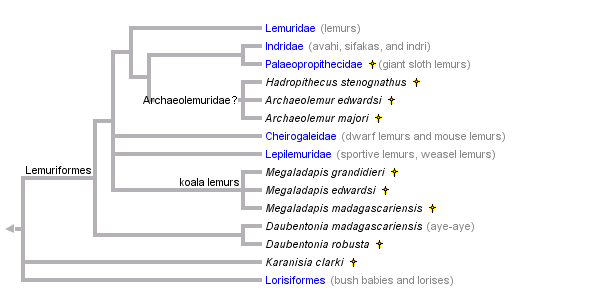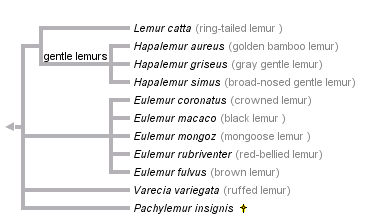|
Classification |
|
|
Kingdom Animalia Phylum Chordata Class Mammalia Order Primates Suborder Prosimii Family Lemuridae Genus Lemur Species Lemur catta |
|
| Ring-Tailed Lemurs are classified into the these divisions because they have the following characteristics: | |
| Kingdom Animalia | Multi-cellular Motile Obtain nutrients by eating or absorbing nutrients from other organisms Cells lack cell walls Have muscle and nervous tissue May reproduce sexually and asexually, but have no alternation of generations Are mostly diploid, but produce haploid gametes for sexual reproduction |
| Phylum Chordata | At some stage in their life, they have a dorsal
hollow nerve chord, notochord, pharyngeal gill slits, and muscular tail
The brain develops from the anterior end of the dorsal hollow nerve chord Have cranium that protects the brain and sensory organs Are active predators and/or herbivores |
| Class Mammalia | Have hair or fur to insulate the body Are endothermic (which helps to maintain high levels of activity) Have mammary glands that allow for lactation Care for young Have facial muscles and lips Jaw is formed from one bone |
| Order Primates | Eyes are located on the front of the face Hands and feet are efficient at grasping Have flattened nails instead of claws on fingers and toes Have large brains relative to body size Have complex social behavior Have extensive care for young |
| Suborder Prosimii | Mostly nocturnal (However ring-tailed lemurs are not nocturnal!) Have large eyes Ears are independently mobile Immobile upper lip Inexpressive face Rely on scent markings |
| Family Lemuridae | Live exclusively in Madagascar Have an elongated snout and small eyes Are herbivores- feed on fruit, flowers, leaves, etc. Are mainly arboreal Hind limbs are longer than forelimbs Have long tails Frequently are quadruped terrestrial walkers |
| Genus Lemur | Have rhinarium (a moist sensitive nose) Have long furry tails used for balance (but they are not prehensile- meaning lemurs cannot hang from their tails)
|
| Species Lemur catta | Have distinctive bushy tail colored with 13 black and white alternating rings |
| Phylogenetic Trees Let's take a step back and trace the ring-tailed lemur's lineage:
|
|
| Eutheria: Placental Mammals Permission for photo use granted from Tree of Life Web Project This tree diagrams the branches of Eutheria, or the placental mammals. Notice that lemurs are found listed under primates. The Primates are close relatives to Scandentia (tree shrews), Chiroptera (bats), and Dermoptera (shrews, moles, hedgehogs, etc.).
|
|
|
Order Primates Permission for photo use granted from Tree of Life Web Project This tree diagrams the branches of Primates. Notice that lemurs are found listed under Strepsirrhini. Within the Order Primates, members of Strepsirrhini are closely related to New World monkeys, humans, great apes, gibbons, Old World monkeys, tarsiers.
|
|
|
Strepsirrhini Permission for photo use granted from Tree of Life Web Project This tree diagrams the branches of Strepsirrhini. Notice that ring-tailed lemurs are found listed under Lemuridae. Within Strepsirrhini, the members of Lemuridae are closely related to a number of other families, including Indridae (avahi, sifakas, and indri), Palaeopropithecidae (giant sloth lemurs), Cheirogaleidae (dwarf lemurs and mouse lemurs), etc.
|
|
|
Family Lemuridae Permission for photo use granted from Tree of Life Web Project This tree diagrams the branches of Family Lemuridae. Notice that ring-tailed lemurs (Lemur catta) are are found listed under Genus Lemur. Within Family Lemuridae, ring-tailed lemurs are closely related to Hapalemur aureus (golden bamboo lemur), Hapalemur griseus (gray gentle lemur) , Hapalemur simus (broad-nosed gentle lemur), Eulemur coronatus (crowned lemur), Varecia variegata (ruffled lemur) etc. |
|
.png)


